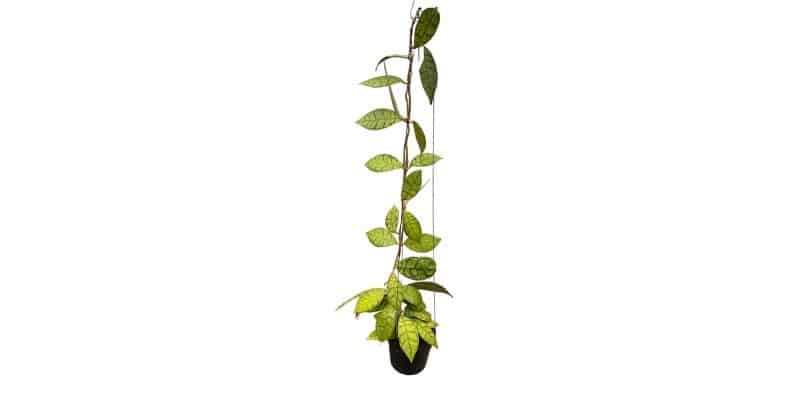Meet Hoya callistophylla — a succulent and an epiphyte with long vines and gorgeous colors that’s sure to become your new green obsession.
Hoya callistophylla features strikingly patterned leaves that can make any plant lover swoon. The best part? It’s actually pretty easy to care for.
We’ll run through everything you need to know about Hoya callistophylla care, from its ideal growing conditions to pro tips on keeping it happy and healthy. So, if you’re ready for a houseplant that’s equal parts elegant and enchanting, let’s grow!
Table of Contents
Hoya Callistophylla Plant Care Guide
History, Habitat, and Characteristics
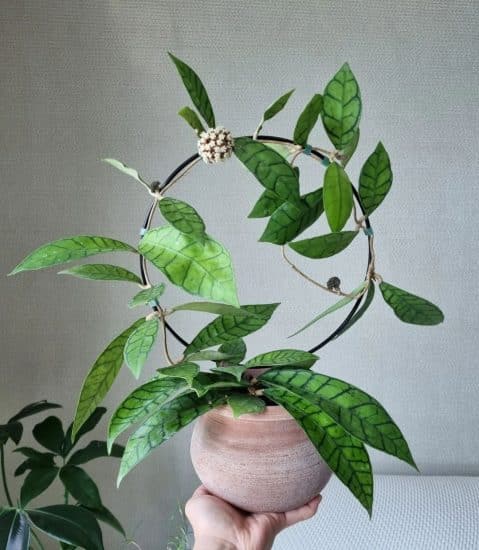
Hoya callistophylla originally hails from the exotic rainforests of Southeast Asia, specifically Malaysia, Thailand, and Borneo.
This member of the Apocynaceae family has an enchanting visual appeal: its stunning oval-shaped green leaves feature darker green veins that create an almost prehistoric appearance. The leaves can reach up to 4-5 inches in size and display remarkable variations in shape and length.
Epiphytic plants like Hoya callistophylla are truly special — they grow on other plants, such as tree branches or trunks, without causing them harm or stealing their nutrients. In fact, even when grown inside, Hoya callistophylla vines can reach up to 16 feet long!
This plant’s adaptive nature is also evident in its ability to change colors under different light conditions. When sun-stressed, which is a technique providing controlled levels of sunlight exposure, the foliage takes on a reddish hue. Keep in mind, though, that sun-scorching can cause the leaves to turn yellow.
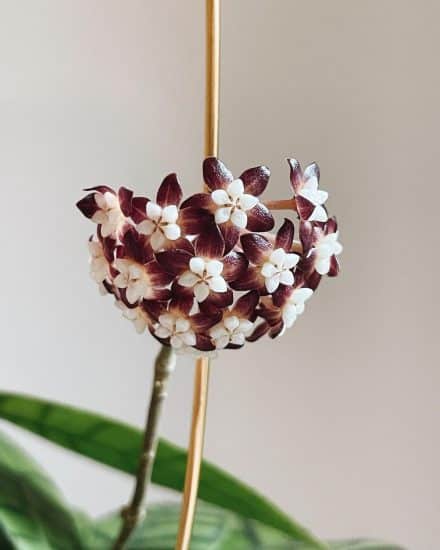
Aromatically, the delightful blooms of Hoya callistophylla will “sweeten” your indoor garden experience. Their tiny, star-shaped, sweetly scented flowers grow in umbel-like clusters. A smeller and a looker!
Fun fact: The Apocynaceae family, to which Hoya callistophylla belongs, comprises approximately 2,700 species! Talk about a family reunion!
Light
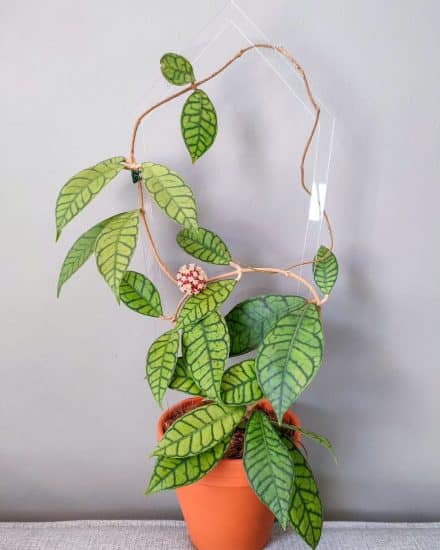
Originating from diverse natural habitats, Hoya callistophylla thrives in morning direct sunlight. This flowering tropical plant can also adapt to less demanding light conditions. An east-facing window is your best bet for sufficient light. Northeastern or northwestern exposure may suffice as well.
Signs of too much sunlight include scorched or browned leaves. If you notice this starting to occur, consider relocating your plant or using sheer curtains to filter the sunlight. During winter months, you can supplement daylight with full-spectrum LED or T5 grow lights for healthy growth during its dormant season.
Not enough light can be detrimental, too. Weak, leggy growth and smaller, pale leaves indicate inadequate lighting. If you observe these signs, try moving your plant closer to a window, or providing artificial light to compensate.
Water
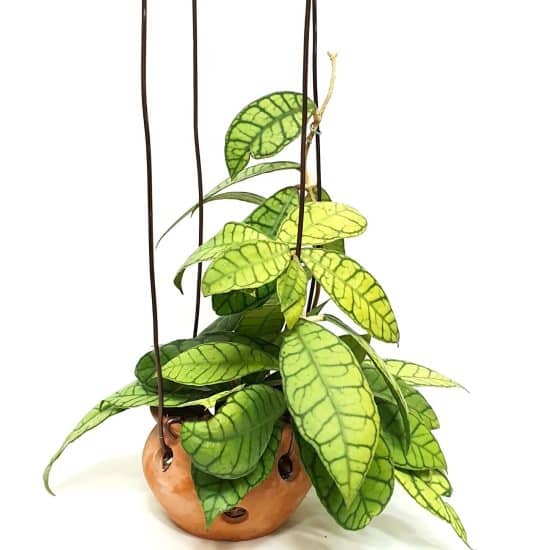
Let your Hoya callistophylla dry out completely between waterings (this helps prevent root rot), and check the soil moisture or the stiffness of the leaves to gauge when it needs water. Aim to water once every one to two weeks, ensuring that the soil is well-saturated. Adjust the frequency during winter when the plant’s growth slows down.
If your Hoya callistophylla isn’t receiving enough water, you’ll notice the plant’s leaves becoming shriveled or wilting. This is a sign that your plant is conserving water by reducing its surface area (a clever adaptive trick). To address this before it becomes an issue, increase the watering frequency and give your plant the hydration it needs.
Yellowing leaves, mushy or weak stems, and consistently moist soil are all signs of overwatering. If you see this, you’ll want to cut back on the watering frequency and let the soil dry out before watering again.
Temperature and Humidity
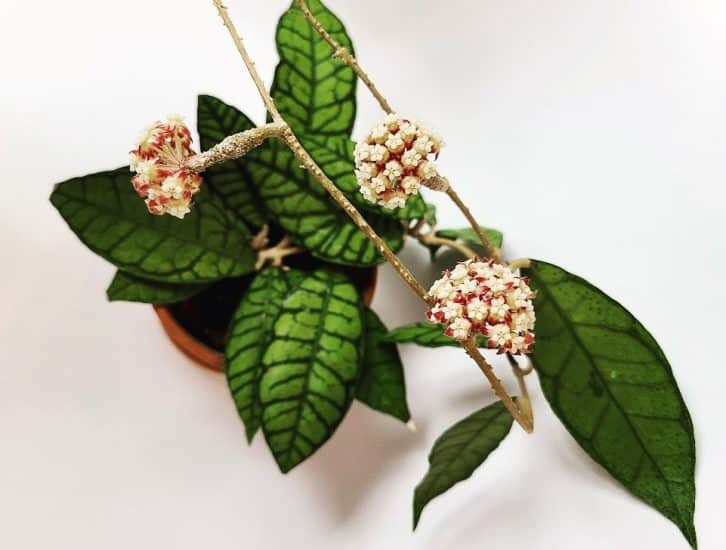
For optimal growth, keep the room temperature range between 60°F to 95°F (15°C to 25°C). Although this vining plant tolerates minor temperature fluctuations, extended exposure outside this range may impact its growth and overall condition.
If you notice wilting, curling, or pale yellow leaves, it’s likely that the temperature is too high or too low for your Hoya callistophylla plant.
When it comes to humidity, Hoya callistophylla prefers levels above 60%. However, it can adapt to drier conditions during the dormant seasons. Wrinkled, shriveled waxy leaves or brown tips are signs that your plant might need more humidity. Alternatively, excessive humidity can result in mold, fungal infection, or pest issues.
Soil and Planting
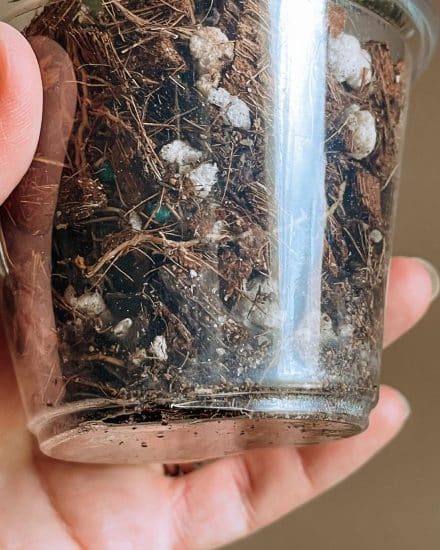
Caring for your Hoya plant means providing it with the right soil mix and proper potting techniques, ensuring it thrives in its environment. Let’s break down the soil composition and potting process.
First, it’s important to focus on creating a well-draining, nutrient-rich mix, such as a 50-50 mix of tropical soil and orchid bark. You can also use straight coconut husks as an alternative. To give you a better idea, here’s a breakdown of the soil ingredients:
- Tropical soil: This has good moisture retention and provides essential nutrients, like nitrogen and organic matter.
- Coconut husks: As an alternative to bark, coconut husks offer similar benefits and can be considered a more sustainable option. They promote good aeration and drainage, helping prevent overwatering issues.
Now, let’s discuss pot selection. Using terracotta pots with drainage holes for Hoya plants is beneficial, since these pots absorb excess water, ensuring the plant’s roots remain healthy (plus, they add a lovely aesthetic touch to your indoor garden).
Fertilizer
During spring and summer, fertilize your Hoya plant about once a month with a mild 1-1-1 ratio of nitrogen-phosphorus-potassium fertilizer, following the label instructions. Reduce the dose by half during the dormancy period to account for slower growth. Your plant will thank you!
Be mindful of over-fertilizing, as it may cause damage to the roots and leaves. If you notice signs of over-fertilization, dilute the fertilizer more, or extend the time between applications.
Repotting
Though Hoya plants don’t require frequent repotting, it’s helpful to know the process when it’s time for a change. Here’s a step-by-step guide:
- Choose a slightly larger pot with good drainage to accommodate your plant’s growing root system.
- Carefully remove the plant from its current pot and gently loosen the root ball to free up compacted roots for healthier growth.
- Place the plant in the new pot with your chosen soil mix, ensuring it’s well-packed but not overly tight.
- Water the plant thoroughly and place it in a suitable location with appropriate light and temperature conditions. Your plant will need some time to adjust.
Lastly, remember that repotting can be an opportunity to encourage flowering. Utilize stress factors such as higher light exposure, smaller pots, and allowing the plant to dry out more than usual (all in moderation). With proper care, your Hoya plant will reward you with stunning, unique flowers!
Propagation
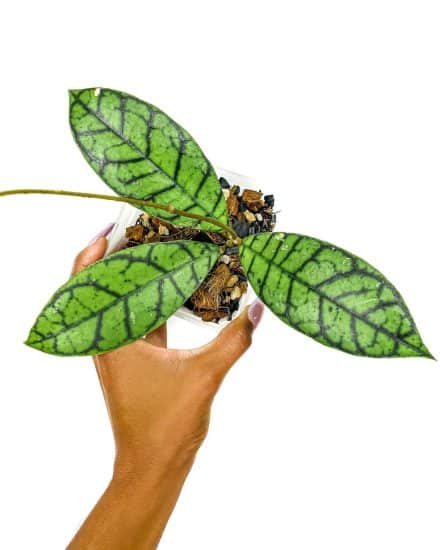
You can easily propagate Hoya callistophylla using stem cuttings in water or sphagnum moss, just as you can with other Hoya species.
Propagating Hoya callistophylla via stem cuttings:
- Select and cut a healthy stem: First, find a vibrant stem with at least one leaf node where new stems may potentially grow. With a sterilized pair of scissors or pruning shears, cut a 4-6 inch section of the stem close to the top of the leaf node, ensuring at least two leaves are attached.
- Remove bottom leaves: Carefully take off any leaves from the bottom 1-2 inches of the stem without damaging the aerial roots along the stem. This step will prevent rotting in water and encourage growth in your cutting.
- Put your cutting in water or sphagnum moss: Place your cutting in a small container with filtered water, bottled water, or rainwater. Alternatively, you can use moistened sphagnum moss to propagate your cutting. Make sure the aerial roots are submerged, but keep the plant’s leaves from touching the water or moss. Locate the container in a spot with bright, filtered sunlight.
- Watch for root growth: Every few days, check your wax plant cutting for root development and change the water as necessary. In about 3-4 weeks, new growth will start sprouting from the aerial roots. When the roots reach approximately 2 inches long, your cutting is ready for planting!
- Plant the rooted cutting: Get a small pot ready with a well-draining, slightly acidic potting mix containing peat moss. Gently cover the roots without burying any leaves. Water the soil to maintain moisture and continue to monitor your cutting in its new environment.
Common Issues
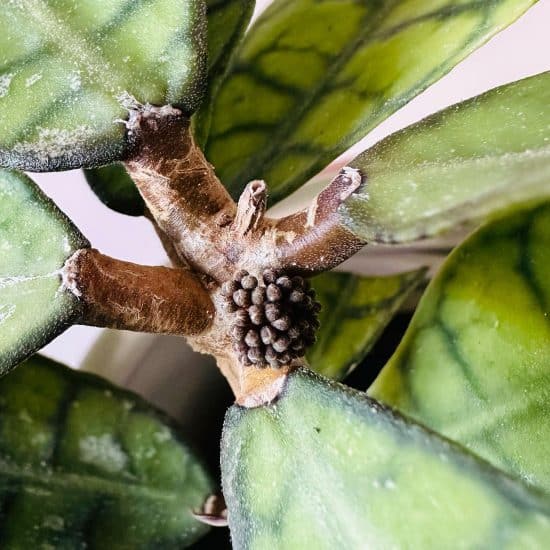
Plants can sometimes face a few hurdles on their growth journeys. We’ll walk you through the issues that Hoya callistophylla (like most Hoya plants) can run into.
Sun Damaged Leaves
In their natural habitat, tropical plants like Hoya callistophylla receive dappled sunlight beneath trees. Do you see yellow or brown patches on your Hoya callistophylla’s leaves? This is a sign of sun damage or sunburn from exposure to direct sunlight.
To prevent further damage, aim for indirect light and watch your plant closely, adjusting its position if necessary.
Tendril/Runner Growth Without Leaves
When Hoya callistophylla tendrils or runners grow longer, but leaves are missing, this is the plant’s way of searching for brighter conditions. Narrow leaves appear when the plant receives the right amount of light.
To remedy this, place your Hoya callistophylla in a spot with more indirect light and wait patiently. Patience is key! Over time, your plant will respond by branching out and sprouting leaves on the tendrils. If the leaves still don’t appear even after relocating, reassess your plant’s overall care, including watering, humidity, and fertilization.
Pests and Diseases
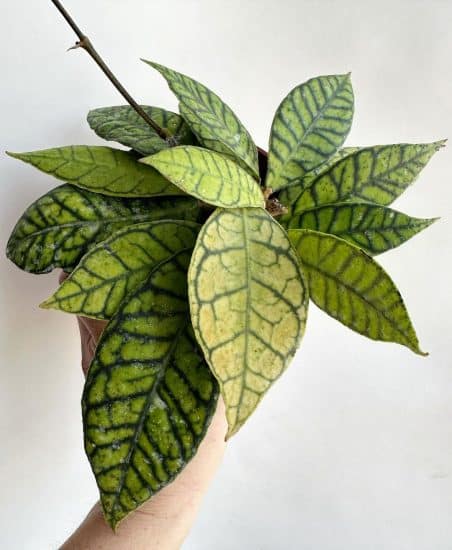
Root Rot
Root rot is a problem that’s very common for indoor plants, including Hoya callistophylla. It usually emerges when a plant has excess water, or when the soil doesn’t drain well.
To resolve this, choose a well-draining potting mix and keep a close watch on your watering routine. Remember to embrace the soak-and-dry method by allowing the soil to partially dry between waterings.
If you spot signs of root rot — such as yellowing leaves, wilting, and a musty smell — gently take your plant out of its pot and cut away any roots that are mushy, dark, and have a funky odor.
Repot your Hoya in fresh, well-draining soil and adjust your watering habits to prevent future occurrences.
Pests
While the Hoya callistophylla plant isn’t especially prone to pest trouble, it’s wise to keep an eye out for the usual indoor plant culprits, such as mealybugs, spider mites, and aphids. Regularly inspect your plant for pest signs like tiny cotton-like clusters or webs.
If you do discover a pest infestation, act fast! Wipe the invaders off with a damp cloth or use a cotton swab dipped in rubbing alcohol.
For more stubborn infestations, you might need to use insecticidal soap or neem oil. Just be sure to follow the application instructions on the label and always isolate your affected plant from other houseplants to prevent spreading.
Conclusion
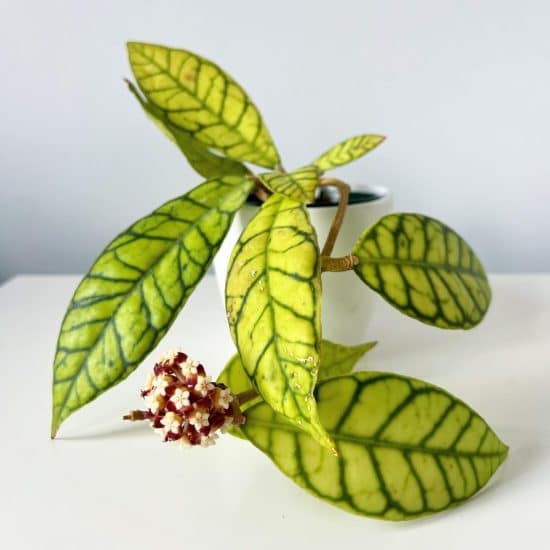
Caring for Hoya callistophylla is relatively simple and is a rewarding choice for tropical plant lovers of all experience levels. Its stunning foliage and unique growth habits add a touch of the exotic to your indoor garden.
Hoya callistophylla care summary:
- Provide bright, indirect light, ideally near an east or north-facing window.
- Keep temperatures between 60° to 95°F (15° to 25°C).
- Aim for humidity levels above 60%.
- Use a well-draining soil mix and properly sized pot, ideally terracotta, for optimal root health.
- Fertilize monthly while you see growth, using a mild 1-1-1 fertilizer. This plant is a slow grower, so don’t be alarmed.
- Propagate by stem cuttings in water or sphagnum moss.
We hope this guide has equipped you with the knowledge to care for your Hoya callistophylla with confidence. Remember, if you have any questions or concerns, feel free to reach out to us. And send us snaps of your growing hoyas (we love to see them too!).
Take care, and happy planting!
FAQ
Is Hoya callistophylla a slow grower?
Hoya callistophylla is known for its moderate growth rate, which can be influenced by various factors like lighting, temperature, and humidity. Providing optimal conditions can encourage healthy growth.
However, patience is key, as it may take some time for your Hoya to establish itself and show significant progress. If you notice slow growth (slower than usual, that is), try adjusting the light and temperature and maintaining a proper watering routine. Each plant is unique, so remember that growth rates between them can vary.
What is the difference between Hoya finlaysonii and Hoya callistophylla?
Though both belong to the Hoya genus, Hoya finlaysonii and Hoya callistophylla have distinct characteristics. Hoya finlaysonii features lance-shaped leaves with creamy-white veins, while Hoya callistophylla has elongated, dark green leaves with silver veining.
The flowers of Hoya finlaysonii are typically yellow or greenish-yellow, whereas those of the Hoya callistophylla boast a creamy white hue.
What is the difference between Hoya callistophylla and Gunung Gading?
Hoya callistophylla and Gunung Gading are actually the same plant, just under different names. “Gunung Gading” refers to the location in Malaysia where this specific Hoya variety was initially discovered.
Since they’re both the same plant . . . it makes sense that they share the same growth requirements and plant characteristics, like elongated, dark green leaves with silver markings and creamy-white flowers.
Does Hoya callistophylla bloom? How can you encourage it to flower?
Yes, Hoya callistophylla can produce beautiful, fragrant flowers when cared for correctly! To encourage blooming, follow these tips:
- Light: If your Hoya doesn’t receive bright, indirect sunlight, it may not flower at all. An east-facing window is usually ideal.
- Fertilization: Proper fertilization can stimulate the production of flower buds. Feed your Hoya monthly with a balanced, water-soluble fertilizer during the growing season (spring and summer).
- Consistency: Stick to a routine of regular watering, adequate light, and the right temperature and humidity levels. Being consistent with your care can set the stage for blooming.
- Pruning: Over-pruning your Hoya may remove potential flower buds. Only snip off dead or damaged growth when necessary.

